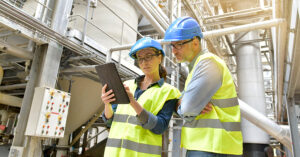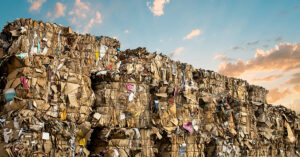Choosing the right baler for specific materials is crucial for businesses handling large volumes of recyclable waste. Balers can optimize material handling, reduce storage needs, streamline logistics, and improve recycling rates.
For business owners, selecting the right baler can seem complex due to the variety of materials involved and the unique specifications of each baler type.
This article will guide you through key factors to consider when choosing a baler for your material needs, whether you’re managing cardboard, plastics, metals, or specialty items.
Understanding the Basics of Balers and Their Role in Material Handling
A baler is a machine designed to compress recyclable materials into compact, manageable bales. Baling materials reduces storage space, eases transportation, and enhances recyclability. While the core purpose of a baler remains the same, the types of balers vary:
- Vertical Balers are ideal for small-to-medium businesses with limited space.
- Horizontal Balers handle high-volume recycling and can automate processes, making them suitable for larger operations.
- Specialty Balers are designed to handle unique materials or high-compaction needs, such as foam or textiles.
Factors to Consider When Choosing a Baler for Specific Materials
1. Material Characteristics and Handling Requirements
Each material has unique characteristics, which significantly impact the type of baler needed.
- Material Type and Composition: Understanding your material’s properties (density, flexibility, moisture content) is crucial. For instance:
- Size and Shape of Incoming Material: Different materials come in various forms (loose, packaged, shredded), impacting how they are fed and compressed.
- Moisture Content: Materials with higher moisture content, like food-contaminated plastics, may necessitate corrosion-resistant balers to prevent wear and tear.
2. Desired Bale Size and Weight
The size and weight of your bales directly impact logistics, storage, and transportation.
- Bale Size and Its Impact on Logistics: Standard bale dimensions ensure efficient stacking and transport. Smaller bales may be easier to handle, but larger bales reduce the number of cycles and labor costs.
- Weight Limits and Safety Requirements: Ensure the selected baler produces bales that meet weight and handling safety standards. Compliance with transport weight restrictions is essential to avoid fines or logistical issues.
3. Volume and Throughput Requirements
Evaluating the volume and throughput of materials helps in selecting the most efficient baler.
- Daily Volume of Material: Low-volume operations benefit from vertical balers, while horizontal or automatic balers are best for medium-to-high-volume facilities.
- Cycle Time and Efficiency: A faster cycle time matches material generation rates, which is crucial for high-output environments, reducing bottlenecks and labor costs.
4. Space and Facility Layout
Your facility’s layout and available space also play an important role in baler selection.
- Available Space for Baler Installation: Businesses with space limitations may need compact vertical balers, while larger facilities can accommodate horizontal balers with additional features.
- Access and Loading Configuration: Some balers are front-loading, while others are top-loading. Choose a configuration that complements your facility’s layout and workflow.
Choosing a Baler Based on Specific Material Needs
1. Balers for Paper and Cardboard
For paper and cardboard, vertical balers are often ideal for small-to-moderate quantities. For high-volume cardboard baling, horizontal balers with auto-tie features streamline operations and minimize manual labor. High compaction ensures denser, uniform bales that are easier to transport and store.
2. Balers for Plastic Materials
The type of plastic—such as PET, HDPE, or film plastics—requires different baling approaches. For stretchy materials like film plastic, balers with perforators or pre-crushers can improve compaction efficiency. Automated horizontal balers are recommended for high-volume plastic recycling due to their continuous feed capability and robust compression.
3. Balers for Metal Waste
Handling metal waste requires heavy-duty balers reinforced to handle the additional weight and strength of metals. Metal balers typically provide high-pressure compaction to accommodate materials such as aluminum and steel. Pre-crusher units are a valuable addition to prepare bulkier metal objects for efficient baling.
4. Specialty Materials: Foam, Textiles, Tires
Unique materials like foam, textiles, and tires call for specialized balers due to their distinct characteristics. Foam’s compression challenges, textiles’ low weight-to-volume ratio, and tires’ durability each require unique baler features to ensure successful handling.
Important Features and Add-ons to Consider
1. Automation and Controls
Semi-automated balers suit businesses with lower volumes and budget constraints. However, fully automated options save labor and maximize efficiency, especially for high-throughput operations. Additionally, smart controls and IoT-enabled monitoring systems provide real-time data on production, maintenance needs, and usage, optimizing baler performance.
2. Safety and Compliance Features
Safety is paramount when handling high-volume recycling equipment. Features like emergency stops, safety interlocks, and compliance with OSHA and industry standards protect operators and improve compliance. Routine inspections and certifications ensure balers meet safety regulations and perform reliably.
3. Financing and Long-term Maintenance Options
Balers are long-term investments, and financing options like leases and payment plans help businesses manage costs. Regular maintenance extends a baler’s lifespan, making service agreements a valuable consideration to ensure uninterrupted operations.
Why Choose Nanoia Recycling Equipment for Your Baler Needs?
Nanoia Recycling Equipment offers a complete solution for your baling needs, from design and fabrication to installation, financing, and ongoing maintenance. With expertise in matching balers to specific materials, our team is equipped to provide custom baling solutions to maximize your efficiency and reduce operational costs.
Contact us today for a tailored solution to your baling needs.






